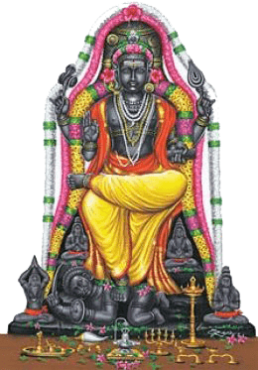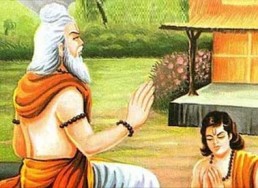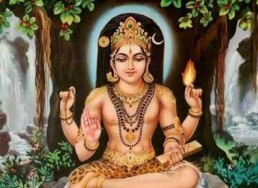Guru Sishya Parampara
अस्मदाचार्य-पर्यन्तां वन्दे गुरु-परम्पराम्॥१॥
asmadācārya-paryantāṃ vande guru-paramparām..1..
येन त्वया भारततैलपूर्णः प्रज्चालितो ज्ञानमयः प्रदीपः ॥२॥
yena tvayā bhāratatailapūrṇaḥ prajcālito jñānamayaḥ pradīpaḥ ..2..
नमामि भगवत्पाद- शङ्करं लोकशङ्करम्॥३॥
namāmi bhagavatpāda- śaṅkaraṃ lokaśaṅkaram..3..
सूत्र-भाष्य-कृती वन्दे भगवन्तौ पुनः पुनः॥४॥
sūtra-bhāṣya-kṛtī vande bhagavantau punaḥ punaḥ..4..
गुरुः साक्षात् परं ब्रह्म तस्मै श्रीगुरवे नमः॥५॥
guruḥ sākṣāt paraṃ brahma tasmai śrīgurave namaḥ..5..
तं हिमवद्-विभूतिं वै ज्ञान-वैराग्य-रूपिणम्॥६॥
taṃ himavad-vibhūtiṃ vai jñāna-vairāgya-rūpiṇam..6..
नमामि चिन्मयं देवं सद्गुरुं ब्रह्मविद्वरम्॥७॥
namāmi cinmayaṃ devaṃ sadguruṃ brahmavidvaram..7..

Description
Guru-Sishya Parampara is the teacher-disciple lineage. Being a civilization that respects experiential knowledge, we hold high respect for the teacher of such knowledge. Below is commentary for selected verses:
sadāśiva-samārambhāṃ śaṅkarācārya-madhyamām.
asmadācārya-paryantāṃ vande guru-paramparām
Salutation to the lineage starting with lord Sadasiva, with Adi Sankara in the middle and continuing up to my immediate teacher.
Being a civilization that respects experiential knowledge, we hold high respect for the teacher of such knowledge. Guru is said to be worthy of such respect and unwavering trust of the disciple, since he takes the responsibility for molding the disciple into what he should be. The disciple that follows Guru’s word with faith, is supposed to be assured of reaching the goals (sometimes irrespective of the personal merit of the teacher).
The Advaita Guru-Paramparā (“Lineage of Gurus in Non-dualism”) is the traditional list (parampara) of divine, Vedic and historical teachers of Advaita Vedanta. It begins with the Daiva-paramparā, the gods; followed by the Ṛṣi-paramparā, the Vedic seers; and then the Mānava-paramparā, with the historical teachers Gaudapada and Shankaracharya, and four of Shankara’s pupils. Of the five contemporary acharyas, the heads of the five Advaita mathas, four acharyas trace their lineage to those four pupils and one to Adi Shankara himself.
Deva, Rsi and Manav Paramparā
The Advaita guru-paramparā (Lineage of Gurus in Non-dualism) begins with the mythological time of the Daiva-paramparā, followed by the vedic seers of the Ṛṣi-paramparā, and the Mānava-paramparā of historical times and personalities:
Daiva-paramparā
Nārāyaṇa
Padmabhuva (Brahmā)
Ṛṣi-paramparā
Vaśiṣṭha
Śakti
Parāśara
Vyāsa
Śuka
Mānava-paramparā
Gauḍapāda
Govinda bhagavatpāda
Śankara bhagavatpāda, and then Shankara’s four disciples
Padmapāda
Hastāmalaka
Toṭaka
Vārtikakāra (Sureśvara) and others
Each Yuga has its own gurus or Acharyas:
In the Satya or Krata Yuga: Lord Narayana and Lord Brahma.
In the Treta Yuga: Vasishta Maharishi, Śakti Maharṣi and Parashara Maharishi.
In the Dvapara Yuga: Veda Vyasa and Sri Shuka Acharya
In the Kali Yuga: Sri Gaudapada Acharya, Govinda Bhagavatpadacharya, Shri Shankarāchārya, and the subsequent lineage.
Jagadgurus of the four Advaita Mathas
According to tradition, Sankara organised a section of the Ēkadaṇḍisannyāsins into the Dashanami Sampradaya, establishing four mathas in north, west, east, and south India, to facilitate the teaching of Advaita Vedanta, and maintain the dharma. He entrusted his four disciples to each of these four mathas. Some of the famous and current Mathadhipatis titled ‘Sankaracharyas’ are listed below:
Sringeri Sharada Peetham
Sri Sacchidananda Shivabhinava Narasimha Bharathi Mahaswami, Jagadguru of Sringeri Sharada Peetham (1865–1912); initiated many into Adi Shankaracharya’s philosophy including Sacchidanandendra Saraswati- founder of Adhyatma Prakashana Karyalaya; known as “Abhinava Shankara” because of his many tours around Bharatvarsha spreading the Advaita Vedanta philosophy and Hindu Dharma
Sri Chandrashekhara Bharathi Mahaswami, Jagadguru of Sringeri Sharada Peetham (1912–1954).
Sri Abhinavavidya Tirtha Mahaswamiji, Jagadguru of Sringeri Sharada Peetham (1954–1989); A great Yogi and master of scriptures. In His many tours of Bharatvarsha and also Nepal He established many maths, shrines and temples.
Sri Bharathi Tirtha Mahaswami, Jagadguru of Sringeri Sharada Peetham (1989- ); A sage and present Jagadguru of Shringeri Peetha, Sringeri, Karnataka.
Jyotir Math
Swaroopanand Saraswati
Govardhan Peetham
Kalika Pitha
This famous sloka lists the essential Advaita Guru parampara as follows:
Sada Shiva Samarambham
Sankaracharya Madhyamam
Asmat aacharya Paryantham
Vande Guru Paramparaa
Which translates as:
Beginning with lord Sadashiva,
With Sankaracharya in the middle,
And till my acharya,
I bow to the tradition of teachers
For more information please visit this wikipedia article.
śrutismrtipurāṇānam alayam karunālayam
namāmi bhagavatpadam sankaram lokaśankaram.
I bow at the feet of the Lord in the form of Sri Sankarācārya, who is the blessing for the humanity, who is the shrine for the śruti, the smrti and the purana, and, who is the abode of compassion.
In this verse, there is a statement of fact: Sri Sankara is srutismrtipurananam alayam. A shrine, a temple, is called alaya. Also any place where a sacred thing is kept is an alaya. Books are sacred, so a library is called pustakalaya. Sri Sankaracarya is an alaya of sruti-smrti-puranas. Sruti is all the Vedas, the karmakanda as well as the last portion of the Vedas known as Vedanta. Since sruti has come down to us through the rishis, there is no authorship (apaurusheyatvam), whereas, smrti has authorship. The kalpa-sutras are a development of the statements of the smrti, written by people who had a status similar to the one the rishis enjoyed. They knew about rituals, values, dharma, etc. All the dharma-sastras come under smrti. Even itihasa is called smrti. It is a combination of history and poetry, unlike Indian history, that is half history and half fiction! The purana appears on a bigger canvas. Its topic is entirely different. It talks about Bhagavan’s avataras. There are 18 puranas. All these together abide in one shrine that is Sri Sankara. He is the upadhi in which the entire subject matter of the sruti, smrti and puranas is enshrined, and is therefore called srutismrtipurananam alayam.
Suppose, there is a living person who is an embodiment of all this vast knowledge but is maunibaba, a person committed to silence, not talking or writing, what would we get? There would be no way for us to learn anything from him. Maunibabas are always respected in our country. If Sri Sankara had been such a maunibaba, he might have had many devotees and one or two generations of those devotees might have remembered him. However, we definitely would not be celebrating his jayanti. Sri Sankara was not only an alaya of all-knowledge, but also an alaya of karuna, a person of great compassion through which he was able to reach out to others. It was Sri Sankara’s compassion, which made him what he was. Let us see how.
Sri Sankara taught his disciples who were with him, but he also made sure that the teaching came down to posterity through his writings. In those days, writing was not an easy job. There were no typewriters; there were no laptops, or even paper and pens. Sri Sankara had to do all his writing on palm leaves, and every copy was handwritten. There are hundreds of such manuscripts in India today, in spite of so many of them having been burnt or lost. They are enshrined in the homes of the people who have them. I do not think there is any culture other than Vedic culture that accords so much value to learning, whether it is scriptural or temporal.
Sri Sankara wrote extensive commentaries, bhashyas, on the Isa, Kena, Katha, Prasna, Mundaka, Mandukya, Taittiriya, Aitareya, Chandogya and the Brhadaranyaka Upanisads. All these bhashyas were written to include purvapaksas, objections and arguments, and the unfolding of the siddhanta, the main purport. When writing bhashyas, first, you have to give the anvaya, comprehensive meaning. After that, you should defend this analysis against any other possible meaning, or any other meaning given by somebody else. If one person thinks in one way, there will always be another person who thinks differently. People say that there are different schools of thought. When you are dealing with the reality, it has to be dealt with exactly as it is. There cannot be different schools of thought in arithmetic because one plus one can only be two. How can there be ‘schools of thought’ in understanding Isvara? But there were people who looked at Isvara differently. Sankara valued them all and discussed in detail leaving nothing to be desired.
You can give people the freedom to hold their ideas. There is nothing wrong in that, but there is no way of reconciling what is right with whatever is wrong. What is right is right. There is nothing to reconcile. A wrong thing has to be stated as wrong and understood as such. The other person has the freedom to hold a wrong idea. That is understandable. However, you cannot accept this wrong idea just because he is a nice person. You cannot have a charismatic approach in dealing with realities.
Thus, we can imagine the enormity of effort in writing all this on palm leaves. How much compassion Sri Sankara must have had for the spiritual upliftment of humanity, that he wrote all these books, and finally, the Brahma-sutra-bhashya. It is no ordinary feat. This is the proof of his compassion. Therefore, he is called srutismrtipurananam alayam karunalayam.
Namami bhagavatpadam sarkaram lokasankaram. I salute him whose name is Sri Śankara. Śam karoti iti Śankarah. Śankara is he who grants mangalam, an auspicious end, the grand finale to the winding journey of a jiva. The jiva’s history has to end. When will it end? Each birth is like yet another sheet of paper in a set of loose sheets that can never be bound together. It is endless; there is always a next birth. It is always an unbound book. The one who brings about that mangalam is Sankara Bhagavatpada, who is likened to Bhagavan. Unto him, my namaskara.
śankaraṁ sankarācāryam keśavam badarāyaṇam
sutrabhāṣyakṛtau vande bhagavantau punaḥ punah.
Salutations again and again to Lord Siva in the form of Śrī Śankarācārya and Lord Vişnu in the form of Veda Vyasa (badarāyana), who were the authors of sutra and bhāṣya.
Śrī Sankara presents the very method of teaching in his commentary. Even though there is no discussion exclusively dealing with the method of teaching in his bhāṣya, Sankara employs the method. We learn how to present a subject-matter, how to expand it and how a word is to be unfolded, how do we come to know exactly what the śruti says in a given sentence-it is for all this that you require a sampradaya. Śrī Sankara says that a teacher should be a sampradaya-vit, a knower of the teaching tradition. He says, asampradayavid mürkhavad upekṣaniyah, just as one keeps away from a murkha, an uninformed person who seriously debates, one has to keep away from asampradayavit. Śrī Sankara identifies with the sampradaya and reveals himself as a sampradaya-vit.
It is also necessary for us to see Śrī Śankara as a sampradaya-kṛt, one who creates and maintains the tradition. He did not say that. It was not necessary for him to do so. Without his revealing the sampradaya through his own bhäşya, there would have been no way for us to approach the śruti and get the vision. In the second chapter of the Brahmasutra-bhāṣya, he deals with the various schools of thought and points out their errors. In doing so, he also reveals himself as a sampradaya-kṛt in a way. Therefore, Śrī Sankara is looked upon as a link in the sampradaya.
Many people wrote commentaries on Śrī Śankara’s bhāṣya to further their own understanding and clarity. We thus have many commentaries available. Some of them are popular. We need not read them all, but they are useful. These commentaries help us in understanding the original.
This wisdom helps one understand that the truth is above all perceived differences. In this, it helps one to become more accommodative of all differences. It is not an accommodation with a patronising attitude, but born of understanding from where the perceptions come. In a healthy dialogue they can be resolved.
Śrī Sankara’s teaching is a blessing to humanity, which is now struggling to cope with the problems of differences. Vande punaḥ punaḥ. To that Śrī Śankarācārya, I offer my salutation again, and again.
samasta jana kalyāṇe nirataṃ karuṇāmayam .
namāmi cinmayaṃ devaṃ sadguruṃ brahmavidvaram
I bow down to my Sadguru. The name is indicated: Chinmayam devam. He is Brahmavidvaram, the shreshtha or best among the knowers of Brahman. For any adhyatmik, spiritual teacher, the most endearing quality there is, is karunamayam, their compassionate nature. They are shrotriyas, brahmanishthas, but they are compassionate teachers. Sometimes, one’s compassion remains limited; generally, in ordinary people, it is limited to near and dear ones, but here it is samasta-jana kalyane, the one who remains ever engaged in the welfare of all people. There are no bars or restrictions. Ignorant people would keep asking why does Swamiji go to America? They would think it is for some fun or an outing, but masters go there because people are there—seekers are there. So, wherever seekers and people are, for those who seek knowledge or other kind of help, masters go for that purpose everywhere.
Other Guru Shlokams
Guru Ashtakam
Guru Ashtakam beautifully exemplifies the necessity of a Guru, beseeching the spiritual seeker to bow down to the Lotus Feet of the Guru. Composed by Sri Adi Shankaracharya.
Guru Brahma
Guru Brahma - Known as Guru Mantra or Guru Mahamantra. The guru is Brahma (Bramha) the guru is Vishnu, the guru is Maheshwara (Siva), the guru is the Self-revealing limitless Brahman. Salutations to that revered guru. - In Sanskrit with English…
Guru Paduka Stotram
Guru Paduka Stotram is a very powerful chant that glorifies the "Padukas (Sandals) of the Guru," which are symbolically represented as "the boat to help cross the endless ocean
Guru Stotram
Guru stotram is a selection of 14 verses from the Guru Geeta, found in Skanda Purana. It is a conversation between Lord Shiva & Parvati on the glory of the Guru. Gu – Darkness. Ru – Remover.
Ishvaro Guru Atmeti
Shlokams,Shiva,Dakshinamurthy,Guru,Sankara
Salutations to Lord Dakshinamurti, who is all-pervasive like space but who appears (as though) divided as Lord, Guru, and the Self.
Sada Shiva Samarambam
Salutation to the lineage starting with lord Sadasiva, with Adi Sankara in the middle and continuing up to my immediate teacher.
Samasta Jana Kalyane
I salute, Shri Chinmaya, the noble teacher, the best of the knowers of Brahman (the highest Reality), and who full of compassion, is ever engaged in the welfare of all people.
Guru Sishya Parampara – Guru – In Sanskrit, English Translation, Meaning, Significance and Audio.


